 |
 |
Our enthusiastic and extremely knowledgeable perennials team is here to answer your questions and help you choose the best perennials for your situation. There’s always something in bloom for sun, shade, butterflies, birds or deer resistance as well as a variety of bulbs for your space.
Stroll through our time-tested favorites and introduce yourself to the newest varieties. We garden with perennials too; we love them and it shows!
|
20 found, showing page 1 of 2
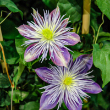
Height: 10 feet
Spread: 24 inches
Sunlight: full sun, partial shade
Hardiness Zone: 4a
Group/Class: Early large-flowered
Description:
Spectacular large, early double lavender-blue flowers with some violet undertones and white, spiky centres, are produced on a vigorous vine, a great plant for the novice and expert gardener alike
Ornamental Features:
Crystal Fountain Clematis features showy lavender star-shaped flowers with violet overtones and white centers at the ends of the branches from late spring to early fall. It has green deciduous foliage. The compound leaves do not develop any appreciable fall color.
Landscape Attributes:
Crystal Fountain Clematis is a multi-stemmed deciduous woody vine with a twining and trailing habit of growth. Its average texture blends into the landscape, but can be balanced by one or two finer or coarser trees or shrubs for an effective composition.
This is a relatively low maintenance woody vine. It is a Type 2 clematis, which means it will bloom primarily on old wood of the previous season, with a second flush later in summer. Dead and weak vines should be removed in late winter, and remaining vines should be trimmed back to the first buds that are seen to remove dead stems. It is a good choice for attracting bees and hummingbirds to your yard. It has no significant negative characteristics.
Crystal Fountain Clematis is recommended for the following landscape applications
- Accent
- Hedges/Screening
- General Garden Use
- Container Planting
- Planting & Growing
Crystal Fountain Clematis will grow to be about 10 feet tall at maturity, with a spread of 24 inches. As a climbing vine, it tends to be leggy near the base and should be underplanted with low-growing facer plants. It should be planted near a fence, trellis or other landscape structure where it can be trained to grow upwards on it, or allowed to trail off a retaining wall or slope. It grows at a medium rate, and under ideal conditions can be expected to live for approximately 20 years.
This woody vine does best in full sun to partial shade. It does best in average to evenly moist conditions, but will not tolerate standing water. It is not particular as to soil type or pH. It is somewhat tolerant of urban pollution. Consider applying a thick mulch around the root zone in both summer and winter to conserve soil moisture and protect it in exposed locations or colder microclimates. This particular variety is an interspecific hybrid.
Crystal Fountain Clematis makes a fine choice for the outdoor landscape, but it is also well-suited for use in outdoor pots and containers. Because of its spreading habit of growth, it is ideally suited for use as a 'spiller' in the 'spiller-thriller-filler' container combination; plant it near the edges where it can spill gracefully over the pot. It is even sizeable enough that it can be grown alone in a suitable container. Note that when grown in a container, it may not perform exactly as indicated on the tag - this is to be expected. Also note that when growing plants in outdoor containers and baskets, they may require more frequent waterings than they would in the yard or garden.
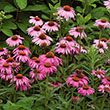
Fully double coral & raspberry blooms. Dark stems & foliage. USDA 4-9

Dark red blooms. Purple toned foliage. Rounded habit. USDA 4-9
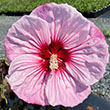
White dinner plate sized flowers with deep pink veining and a large eye. USDA 4-9
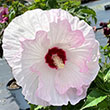
Large white ruffled flowers with a red center and blush pink edges. Upright, shrub-like. USDA 4-9
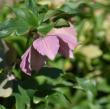
Height: 18 inches
Spacing: 14 inches
Sunlight: partial shade, full shade
Hardiness Zone: 4a
Other Names: Pine Knot Best Strain, Lenten Rose, Winter Rose
Group/Class: Pine Knot Select Mix
Description:
Large nodding buttercup-type single to semi-double blooms are a wide mix of colors, including various shades and tints of white, pink, red, purple, and yellow; great in woodland gardens and on shaded slopes
Ornamental Features:
Pine Knot Select Hellebore features showy nodding rose cup-shaped flowers with purple overtones at the ends of the stems from late winter to early spring. Its glossy oval compound leaves emerge lime green in spring, turning bluish-green in color the rest of the year.
Landscape Attributes:
Pine Knot Select Hellebore is an herbaceous evergreen perennial with an upright spreading habit of growth. Its medium texture blends into the garden, but can always be balanced by a couple of finer or coarser plants for an effective composition.
This is a relatively low maintenance plant, and should be cut back in late fall in preparation for winter. Deer don't particularly care for this plant and will usually leave it alone in favor of tastier treats. It has no significant negative characteristics.
Pine Knot Select Hellebore is recommended for the following landscape applications:
- Mass Planting
- Rock/Alpine Gardens
- Border Edging
- General Garden Use
- Naturalizing And Woodland Gardens
Planting & Growing
Pine Knot Select Hellebore will grow to be about 14 inches tall at maturity, with a spread of 18 inches. When grown in masses or used as a bedding plant, individual plants should be spaced approximately 14 inches apart. Its foliage tends to remain dense right to the ground, not requiring facer plants in front. It grows at a medium rate, and under ideal conditions can be expected to live for approximately 5 years. As an evegreen perennial, this plant will typically keep its form and foliage year-round.
This plant does best in partial shade to shade. It does best in average to evenly moist conditions, but will not tolerate standing water. It is not particular as to soil pH, but grows best in rich soils. It is somewhat tolerant of urban pollution, and will benefit from being planted in a relatively sheltered location. This particular variety is an interspecific hybrid, and parts of it are known to be toxic to humans and animals, so care should be exercised in planting it around children and pets. It can be propagated by division; however, as a cultivated variety, be aware that it may be subject to certain restrictions or prohibitions on propagation.
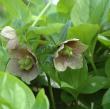
Lenten Rose | White to rose-purple blooms. Mounding. Evergreen USDA 4-9
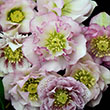
Height: 24 inches
Spacing: 18 inches
Sunlight: partial shade, full shade
Hardiness Zone: 4a
Other Names: Lenten Rose, Winter Rose
Group/Class: Wedding Party Series
Brand: Walters Gardens
Description:
An easy to grow selection producing romantic double blooms in shades of light pink; blooms emerge in late winter and early spring above attractive green foliage; ideal for shade gardens; great as cut flowers or in borders and beds
Ornamental Features:
Wedding Party Flower Girl Hellebore features showy nodding shell pink cup-shaped flowers with pink overtones at the ends of the stems from late winter to early spring. Its glossy pointy compound leaves remain green in color throughout the year.
Landscape Attributes:
Wedding Party Flower Girl Hellebore is an herbaceous evergreen perennial with an upright spreading habit of growth. Its medium texture blends into the garden, but can always be balanced by a couple of finer or coarser plants for an effective composition.
This is a relatively low maintenance plant, and should be cut back in late fall in preparation for winter. Deer don't particularly care for this plant and will usually leave it alone in favor of tastier treats. It has no significant negative characteristics.
Wedding Party Flower Girl Hellebore is recommended for the following landscape applications:
- Mass Planting
- Rock/Alpine Gardens
- Border Edging
- General Garden Use
- Naturalizing And Woodland Gardens
Planting & Growing:
Wedding Party Flower Girl Hellebore will grow to be about 20 inches tall at maturity, with a spread of 24 inches. When grown in masses or used as a bedding plant, individual plants should be spaced approximately 18 inches apart. Its foliage tends to remain dense right to the ground, not requiring facer plants in front. It grows at a medium rate, and under ideal conditions can be expected to live for approximately 5 years. As an evegreen perennial, this plant will typically keep its form and foliage year-round.
This plant does best in partial shade to shade. It does best in average to evenly moist conditions, but will not tolerate standing water. This plant should not require much in the way of fertilizing once established, although it may appreciate a shot of general-purpose fertilizer from time to time early in the growing season. It is not particular as to soil pH, but grows best in rich soils. It is somewhat tolerant of urban pollution, and will benefit from being planted in a relatively sheltered location. This particular variety is an interspecific hybrid, and parts of it are known to be toxic to humans and animals, so care should be exercised in planting it around children and pets. It can be propagated by division; however, as a cultivated variety, be aware that it may be subject to certain restrictions or prohibitions on propagation.
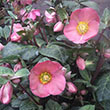
Penny's Pink' Hellebore | Muave outward-facing blooms. Marbled evergreen foliage. USDA 4-9

Height: 22 inches
Spacing: 18 inches
Sunlight: partial shade, full shade
Hardiness Zone: 4a
Other Names: Lenten Rose, Winter Rose
Group/Class: Honeymoon Series
Brand: Proven Winners
Description:
This attractive variety produces bushy mounds of thick evergreen leaves; flower stalks bear showy, cup shaped blooms in shades of pink with purple edges; a great selection for shade gardens
Ornamental Features:
Honeymoon Paris In Pink Hellebore features showy nodding pink cup-shaped flowers with purple edges at the ends of the stems from late winter to early spring. Its attractive serrated oval compound leaves remain dark green in color throughout the year.
Landscape Attributes:
Honeymoon Paris In Pink Hellebore is an herbaceous evergreen perennial with an upright spreading habit of growth. Its medium texture blends into the garden, but can always be balanced by a couple of finer or coarser plants for an effective composition.
This is a relatively low maintenance plant, and should be cut back in late fall in preparation for winter. Deer don't particularly care for this plant and will usually leave it alone in favor of tastier treats. It has no significant negative characteristics.
Honeymoon Paris In Pink Hellebore is recommended for the following landscape applications:
- Mass Planting
- Rock/Alpine Gardens
- Border Edging
- General Garden Use
- Naturalizing And Woodland Gardens
Planting & Growing:
Honeymoon Paris In Pink Hellebore will grow to be about 18 inches tall at maturity, with a spread of 24 inches. When grown in masses or used as a bedding plant, individual plants should be spaced approximately 18 inches apart. Its foliage tends to remain dense right to the ground, not requiring facer plants in front. It grows at a medium rate, and under ideal conditions can be expected to live for approximately 5 years. As an evegreen perennial, this plant will typically keep its form and foliage year-round.
This plant does best in partial shade to shade. It does best in average to evenly moist conditions, but will not tolerate standing water. It is not particular as to soil pH, but grows best in rich soils. It is somewhat tolerant of urban pollution, and will benefit from being planted in a relatively sheltered location. This particular variety is an interspecific hybrid, and parts of it are known to be toxic to humans and animals, so care should be exercised in planting it around children and pets. It can be propagated by division; however, as a cultivated variety, be aware that it may be subject to certain restrictions or prohibitions on propagation.
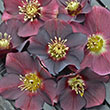
Deep-magenta blooms accented with golden-yellow centers. USDA 4-9
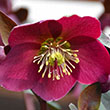
'Anna's Red' Hellebore | Burgundy outward facing blooms. Marbled foliage. Evergreen. USDA 4-9

Pale yellow single blooms with deep red centers. Evergreen. USDA 4-9
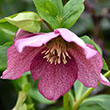
Blooms in purple, red, pink, green, & white. Evergreen. USDA 4-9
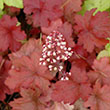
Plant Height: 9 inches
Flower Height: 14 inches
Spacing: 12 inches
Sunlight: full sun, partial shade, full shade
Hardiness Zone: 4a
Other Names: Coralbells, Alumroot
Description:
The reddest foliage in spring turns radiant copper-orange with red veins, returning to red in fall; pink bells in early summer; amazing color addition with great versatility; keep soil moist in heat of summer
Ornamental Features:
Fire Alarm Coral Bells features dainty spikes of pink bell-shaped flowers rising above the foliage in early summer. Its attractive tomentose lobed leaves emerge crimson in spring, turning orange in color with distinctive dark red veins. The foliage often turns crimson in fall.
Landscape Attributes:
Fire Alarm Coral Bells is a dense herbaceous evergreen perennial with tall flower stalks held atop a low mound of foliage. Its relatively fine texture sets it apart from other garden plants with less refined foliage.
This is a relatively low maintenance plant, and should be cut back in late fall in preparation for winter. It is a good choice for attracting hummingbirds to your yard. It has no significant negative characteristics.
Fire Alarm Coral Bells is recommended for the following landscape applications:
- Mass Planting
- Rock/Alpine Gardens
- Border Edging
- General Garden Use
- Groundcover
- Container Planting
- Planting & Growing
Fire Alarm Coral Bells will grow to be about 9 inches tall at maturity extending to 14 inches tall with the flowers, with a spread of 14 inches. When grown in masses or used as a bedding plant, individual plants should be spaced approximately 12 inches apart. Its foliage tends to remain low and dense right to the ground. It grows at a medium rate, and under ideal conditions can be expected to live for approximately 10 years. As an evegreen perennial, this plant will typically keep its form and foliage year-round.
This plant performs well in both full sun and full shade. However, you may want to keep it away from hot, dry locations that receive direct afternoon sun or which get reflected sunlight, such as against the south side of a white wall. It prefers to grow in average to moist conditions, and shouldn't be allowed to dry out. It is not particular as to soil type or pH. It is somewhat tolerant of urban pollution. Consider covering it with a thick layer of mulch in winter to protect it in exposed locations or colder microclimates. This particular variety is an interspecific hybrid. It can be propagated by division; however, as a cultivated variety, be aware that it may be subject to certain restrictions or prohibitions on propagation.
Fire Alarm Coral Bells is a fine choice for the garden, but it is also a good selection for planting in outdoor pots and containers. It is often used as a 'filler' in the 'spiller-thriller-filler' container combination, providing a mass of flowers and foliage against which the larger thriller plants stand out. Note that when growing plants in outdoor containers and baskets, they may require more frequent waterings than they would in the yard or garden.
20 found, showing page 1 of 2













